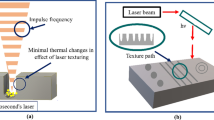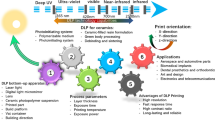Abstract
Surface Submicron grating manufacturing has broad application prospects, which has also been the subject of intensive research and development by scholars with many efforts. In this paper, a grating coloring manufacturing method is proposed based on three-dimensional elliptical vibration cutting and non-resonant piezoelectric actuator. Based on the mechanism of elliptical motion, an effective cutting depth model was established. Nonlinear interaction of machining parameters (overlap rate, nominal cutting speed, vibration frequency) on the geometry of the grating were analyzed and controllable modulation model of grating geometry was established. The geometrical dimensions of the grating were predicted and grooved experiments were performed on brass and aluminum surfaces. A set of angle-adjustable detection device was designed independently to check the diffraction quality of the grating. The quantitative experimental results show that grating distances of copper and aluminum rods are 752 nm and 684 nm, respectively. The average width of the aluminum rod overall grating is 764 nm, the accuracy error is 9.25%. In addition, aluminum rod gratings can diffract red light at non-specific angles, which is more effective at viewing angle of 70°. The experimental results are in agreement with the theory which have positive significance for expanding the functional surface.







Similar content being viewed by others
Abbreviations
- OR :
-
Critical overlap rate
- v f :
-
Spindle velocity
- τ :
-
Cross feed (Z axis)
- V C :
-
Nominal cutting velocity
- f :
-
Tool vibration frequency
- ω :
-
Angular velocityof drive signal
- φ 1, φ 2, φ 3 :
-
Phase of the drive signal in three axes
- a,b :
-
Semi-major amplitude in x,y axis direction
- θ :
-
Angle corresponding to the toolnose coordinate at time t
- ϕ t :
-
Phase shift between the two axes at time t (time/s)
- A 1 , A 2 , A 3 :
-
Vibration amplitude of signal in the X-axis and Y-axis
- Y 1 , Y 2 , Z 1 :
-
Drive signals applied by the three PEA in the device
- α , β :
-
Light incident angle and the angle of diffracted beams of order m
- p :
-
Grating period
- D :
-
Grating distance
- R P :
-
Resolution of grating
- λ :
-
The wavelength
- H effect :
-
Effective depth of cut
- PEA :
-
Piezoelectric actuator
- m :
-
Integer indicating the diffractionorder
- 3D–EVC :
-
Three-dimensional elliptical vibration cutting
- LIPSS :
-
Laser-induced periodic surface structure
- X s , Y s , Z s :
-
Vibrationdisplacement of signal in the X-axis and Y-axis
- ω 1 , ω 2 , ω Z :
-
Angular velocityof the drive signal in three axes
- σλ :
-
Analytic minimum wavelength interval at wavelengtht λt
- L 1 , L 2 :
-
Vertical distance from the driving point of PEA to the Y–O–Z plane
References
Benjamin Dusser, Z., Sagan, H. S., Faure, N., & Audouard, E. (2010). Controlled nanostructrures formation by ultra fast laser pulses for color marking. Optics Express, 18(3), 2913–2924.
Liu, J., & Coleman, J. P. (2000). Nanostructured metal oxides for printed electrochromic displays. Materials Science & Engineering A, 286(1), 144–148.
Ergin, T., Stenger, N., Brenner, P., Pendry, J. B., & Wegener, M. (2010). Three-dimensional invisibility cloak at optical wavelengths. Science, 328(5976), 337–339.
Parker, A. R. (2000). 515 million years of structural colour. Journal of Optics A: Pure and Applied Optics, 2(6), R15.
Lee, T., Jang, J., Jeong, H., & Rho, J. (2018). Plasmonic-and dielectric-based structural coloring: from fundamentals to practical applications. Nano Convergence, 5(1), 1–21.
Kinoshita, S., Yoshioka, S., & Miyazaki, J. (2008). Physics of structural colors. Reports on Progress in Physics, 71(7), 076401.
Guo, P., & Ehmann, K. F. (2013). An analysis of the surface generation mechanics of the elliptical vibration texturing process. International Journal of Machine Tools & Manufacture, 64, 85–95.
Vorobyev, A. Y., & Guo, C. (2008). Colorizing metals with femtosecond laser pulses. Applied Physics Letters, 92(4), 041914.
Ahsan, M. S., Ahmed, F., Kim, Y. G., Lee, M. S., & Jun, M. B. G. (2011). Colorizing stainless steel surface by femtosecond laser induced micro/nano-structures. Applied Surface Science, 257(17), 7771–7777.
Ou, Z., Huang, M., & Zhao, F. (2014). Colorizing pure copper surface by ultrafast laser-induced near-subwavelength ripples. Optics express, 22(14), 17254–17265.
Long, J., Fan, P., Zhong, M., Zhang, H., Xie, Y., & Lin, C. (2014). Superhydrophobic and colorful copper surfaces fabricated by picosecond laser induced periodic nanostructures. Applied Surface Science, 311, 461–467.
Lin, J., Lu, M., & Zhou, X. (2013). Development of a non-resonant 3d elliptical vibration cutting apparatus for diamond turning. Experimental Techniques, 40(1), 173–183.
Nath, C., & Rahman, M. (2008). Effect of machining parameters in ultrasonic vibration cutting. International Journal of Machine Tools and Manufacture, 48(9), 965–974.
Lu, M., Chen, J., Zhao, D., Lin, J., Zhu, Z., Chen, B., & Yi, A. (2019). Modeling and realization of work-space analysis of a piezoelectric actuator 2-DOF vibration-assisted swing cutting system. Applied Nanoscience, 12, 1–9.
Wu, X., Li, L., Zhao, M., & He, N. (2016). Experimental investigation of specific cutting energy and surface quality based on negative effective rake angle in micro turning. The International Journal of Advanced Manufacturing Technology, 82(9–12), 1941–1947.
Shamoto, E., & Moriwaki, T. (1994). Study on elliptical vibration cutting. CIRP annals, 43(1), 35–38.
Guo, P., Lu, Y., Pei, P., & Ehmann, K. F. (2014). Fast generation of micro-channels on cylindrical surfaces by elliptical vibration texturing. Journal of Manufacturing Science and Engineering, 136(4), 561–565.
Dornfeld, D., Min, S., & Takeuchi, Y. (2006). Recent advances in mechanical micromachining. CIRP annals, 55(2), 745–768.
Palmer, E. W., Hutley, M. C., Franks, A., Verrill, J. F., & Gale, B. (2001). Diffraction gratings (manufacture). Reports on Progress in Physics, 38(8), 975.
Lu, M., Wang, H., Guan, L., Lin, J., Gu, Y., Chen, B., & Zhao, D. (2018). Modeling and analysis of surface topography of Ti6Al4V alloy machining by elliptical vibration cutting. The International Journal of Advanced Manufacturing Technology, 98(9–12), 2759–2768.
Yang, Y., Pan, Y., & Guo, P. (2017). Structural coloration of metallic surfaces with micro/nano-structures induced by elliptical vibration texturing. Applied Surface Science, 402, 400–409.
Kim, G. D., & Loh, B. G. (2007). Characteristics of elliptical vibration cutting in micro-V grooving with variations in the elliptical cutting locus and excitation frequency. Journal of micromechanics and microengineering, 18(2), 025002.
Tan, S. J., Zhang, L., Zhu, D., Goh, X. M., Wang, Y. M., Kumar, K., & Yang, J. K. (2014). Plasmonic color palettes for photorealistic printing with aluminum nanostructures. Nano letters, 14(7), 4023–4029.
Wang, Y., Zou, B., & Huang, C. (2019). Tool wear mechanisms and micro-channels quality in micro-machining of Ti-6Al-4V alloy using the Ti (C7N3)-based cermet micro-mills. Tribology International, 134, 60–76.
Shamoto, E., & Suzuki, N. (2009). Development of elliptical vibration cutting technology and its application to ultraprecision/micro machining of hard/brittle materials. Advanced Materials Research, 69–70, 133–137.
Poitras, D., Dobrowolski, J. A., Cassidy, T., Midwinter, C., & McElroy, C. T. (2002). Black layer coatings for the photolithographic manufacture of diffraction gratings. Applied optics, 41(16), 3306–3311.
Ponomarenko, S. A., & Wolf, E. (2002). Spectral anomalies in a Fraunhofer diffraction pattern. Optics letters, 27(14), 1211–1213.
Boudebs, G., & Cherukulappurath, S. (2004). Nonlinear optical measurements using a 4 f coherent imaging system with phase objects. Physical Review A, 69(5), 053813.
Funding
This project is supported by National Natural Science Foundation of China (Grant No. 51905046), Key Projects of Jilin Province Talent Development Fund, Micro-Nano and Ultra-Precision Key Laboratory of Jilin Province (20140622008JC), Science and Technology Development Projects of Jilin Province (20190201303JC).
Author information
Authors and Affiliations
Corresponding author
Ethics declarations
Conflict of interests
The author declares that he has no conflict of interest.
Additional information
Publisher's Note
Springer Nature remains neutral with regard to jurisdictional claims in published maps and institutional affiliations.
Rights and permissions
About this article
Cite this article
Chen, J., Lu, M., Lin, J. et al. Non-resonant 3D Elliptical Vibration Cutting Induced Submicron Grating Coloring. Int. J. Precis. Eng. Manuf. 22, 659–669 (2021). https://doi.org/10.1007/s12541-021-00470-9
Received:
Revised:
Accepted:
Published:
Issue Date:
DOI: https://doi.org/10.1007/s12541-021-00470-9




